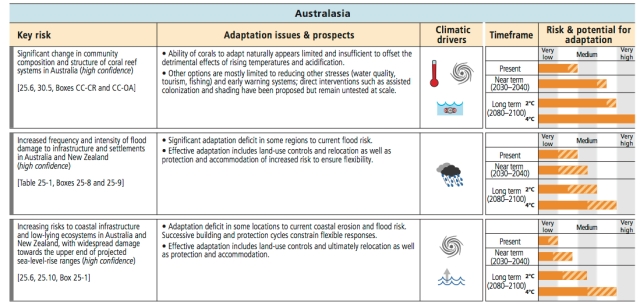Summary of climate change impacts
Posted on 9 March 2015 by
This is a re-post from And Then There's Physics
I commented that I’d like to understand the actual impacts of anthropogenic climate change better than I currently do. It’s one thing to understand that if we continue to increase our emissions, we’ll continue to warm, sea level will rise, polar ice will melt, and the hydrological cycle will intensify; it’s another to understand quite what impact these changes will actually have.
VTG, quite rightly, pointed out that there is already a lot of information about this in the IPCC reports, so I went and looked where he suggested. The WGII Summary for Policy Makers (SPM) – in particular Table 1 – is very detailed and probably illustrates Victor’s point; impact studies are inherently regional, which introduces large uncertainties. It also seems to make communicating this quite difficult; there are many regions and multiple impacts per region. Therefore, there’s isn’t a small set of nice soundbites that can be used to illustrate these impacts; you really do need to delve into them in quite some detail.
So, I thought I would try and do a bit of that here. The table in the SPM recommended by VTG is actually pretty detailed; it includes a range of impacts for each region, the confidence in each projection, the climate drivers, the risks for different timeframes, and the potential for adaptation (being WGII, this report focused mainly on adaptation). What I thought I would do below is reproduce the part of the table for each region and highlight one impacts, for each region, for which there is high confidence.
Africa :
- Reduced crop productivity associated with heat and drought stress, with strong adverse effects on regional, national, and household livelihood and food security, also given increased pest and disease damage and flood impacts on food system infrastructure. Under a high-emission pathway, the long-term risk is very high with little potential for adaptation.
Europe:
- Increased water restrictions. Significant reduction in water availability from river abstraction and from groundwater resources, combined with increased water demand and with reduced water drainage and runoff as a result of increased evaporative demand, particularly in southern Europe. Risk is medium-to-high with some potential for adaptation.
Asia:
- Increased risk of heat-related mortality. Under a high-emission pathway, the long-term risk is very high with little potential for adaptation.
Australasia:
- Increased frequency and intensity of flood damage to infrastructure and settlements in Australia and New Zealand. The long-term risk is medium with potential for adaptation.
North America:
- Wildfire-induced loss of ecosystem integrity, property loss, human morbidity, and mortality as a result of increased drying trend and temperature trend. Under a high-emission pathway, the long-term risk is very high with not much potential for adaptation.
Central and South America:
- Spread of vector-borne diseases in altitude and latitude. In the medium-term this carries medium risk with potential for adaptation. No long-term risk information.
Polar regions:
- Risks for the health and well-being of Arctic residents, resulting from injuries and illness from the changing physical environment, food insecurity, lack of reliable and safe drinking water, and damage to infrastructure, including infrastructure in permafrost regions. Long-term risk is high, but with potential for adaptation.
Small Islands:
- Loss of livelihoods, coastal settlements, infrastructure, ecosystem services, and economic stability. Under a high-emission pathway, the long-term risk is very high, but with some potential for adaptation.
Oceans:
Reduced biodiversity, fisheries abundance, and coastal protection by coral reefs due to heat-induced mass coral bleaching and mortality increases, exacerbated by ocean acidification, e.g., in coastal boundary systems and sub-tropical gyres. Under a high-emission pathway, the long-term risk is very high with no potential for adaptation.
So, there’s my attempt to look at some of the projected climate impacts. I’ve only highlighted one per region, but these are risks for which there is high-confidence and there is more information in the tables themselves. It’s clear that this is a very complex issue with no obviously easy way to communicate these potential risks. However, I do think that this is a very important issue and I would certainly like to understand it better, and also see it more prominently communicated.































 Arguments
Arguments







































Good post, Anders. You (and SkS readers) may be interested in the series of posts I did at Global Warming Fact of (the Day last May on the impacts of climate change. I also used the WG II report as a rough guide to specific impacts around the globe.
Thanks for this post. Some of those high level reports are heavy going so I am reluctant to recommend them to my (high school) students. Your post is a good summary that I am more than happy to add to the recommended reading list. Slightly off topic but I'm getting more enquiry about AGW from my students than I have in the last few years. I have a science background but not in climate science so summaries like this are good for me too!
Tim
uncletimrob - It's very good to hear that your students are becoming more aware of the issues.
I would suggest that if interested you go to the IPCC reports (the most recent AR5 here) and read through the individual sections 'Summary for Policymakers' for overviews of the science, impacts, mitigation, etc. Those are written for non-experts, and present a good layout of what we know. Follow up with the 'Technical Summary' for any report you have more detailed interest in.
As an example, here's Figure SPM.2 from AR5 WGII showing the distribution of climate change impacts:
[Larger] [Source]